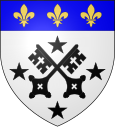Lisieux
| Lisieux | ||
|---|---|---|

|
|
|
| region | Normandy | |
| Department | Calvados | |
| Arrondissement | Lisieux ( sub-prefecture ) | |
| Canton | Lisieux | |
| Community association | Lisieux Normandy | |
| Coordinates | 49 ° 9 ′ N , 0 ° 14 ′ E | |
| height | 32-152 m | |
| surface | 13.07 km 2 | |
| Residents | 20,318 (January 1, 2017) | |
| Population density | 1,555 inhabitants / km 2 | |
| Post Code | 14100 | |
| INSEE code | 14366 | |
| Website | www.ville-lisieux.fr | |
 The Sainte-Thérèse basilica |
||
Lisieux is a town with 20,318 inhabitants (as of January 1, 2017) in the French region of Normandy in the Calvados department . It is the seat of the sub-prefecture (French sous-préfecture ) of the Arrondissement of Lisieux . This consists of 13 cantons ; the city itself is divided into three cantons. It is also the capital of the Pays d'Auge . The residents are still called Lexoviens after the original Celtic name of the place .
geography
Lisieux is located on the Touques River about 30 km south of the Seine estuary. In the urban area, the Orbiquet flows into the Touques as a right tributary.
Lisieux has a train station on the Paris – Cherbourg railway line ; the journey time to Paris Gare Saint-Lazare is one hour and forty minutes.
history

The city was mentioned as Noviomagus Lexoviorum as far back as Roman times . From the High Middle Ages to the Revolution, Lisieux was ruled by the powerful bishop counts who made their city a flourishing metropolis. In the 19th century it gradually lost its religious and then its economic importance.
Lisieux regained importance in the 20th century. The city was the seat of a Carmelite for pilgrimage that its fame to the nun Thérèse Martin, better known as Therese of the Child Jesus , owes. After her death in 1897, devotion to the Carmelite became widespread; she was beatified in 1923 and canonized in 1925. The church, built from 1929 to 1954 (inauguration) in neo-Romanesque style, is dedicated to her here. After Lourdes, the city is the second largest pilgrimage site in France with almost one and a half million pilgrims and visitors every year.
After destruction by Allied air raids from June 6th to 8th, 1944 on German positions that had been set up in the city to make the advance on Paris more difficult, the city was liberated by the Allies on August 23, 1944. In the 1950s, the city was rebuilt in a contemporary post-war style. The 70th anniversary of the liberation in 2014 was celebrated across the region, with guests including elderly regional veterans of the fighting at the time. There are two military cemeteries in Saint-Désir, both for British liberators and for people from the Wehrmacht.
Population development
| year | 1962 | 1968 | 1975 | 1982 | 1990 | 1999 | 2006 | 2016 |
| Residents | 21,156 | 23,830 | 25,521 | 24,940 | 23,703 | 23,166 | 23,343 | 20,301 |
| Sources: Cassini and INSEE | ||||||||
Attractions
- Basilica Ste. Thérèse : one of the largest churches built in the 20th century
- Chapelle du Carmel
- St-Pierre Cathedral: built 1170–1250, Romanesque / Gothic, south tower from the 16th century
- Half-timbered buildings and mansions
- Jardin archéologique
- Jardin de l'Eveché: park in the center of Lisieux, next to the cathedral, designed by André Le Nôtre , the architect of the Palace of Versailles park
- Saint-Germain-de-Livet Castle : from the 15th / 16th centuries Century, owned by the city since 1958
- Jardin de l'Abbé Marie: Park in the former cemetery area
- Le Musée d'Art et d'Histoire: The Museum of Art and History has archaeological, ethnological and iconographic exhibits, 38 boulevard Pasteur.
- Le Domaine Saint Hippolyte: stately home from the 15th / 16th centuries Century, 3 km south of Lisieux
- Le Château du Pré d'Auge: with the Saint Méen church and fountain
Town twinning
Lisieux since 1997 by twinning associated with the English town of Taunton in the county of Somerset , with the Italian town of Mogliano Veneto in Veneto and the Canadian city of St-Georges-de-Beauce in the province of Quebec .
There are friendly contacts with the German Hanseatic city of Wesel on the Lower Rhine .
Personalities
- Charles-Alexandre Coëssin de la Fosse (1829–1910), painter and etcher.
- Tony Hurel (* 1987), road cyclist
Web links
Individual evidence
- ↑ Ouest-France , edition for the Calvados region, July 31, 2014, p. 7.
- ↑ Comité des jumelages de Lisieux! Retrieved March 6, 2019 (French).

